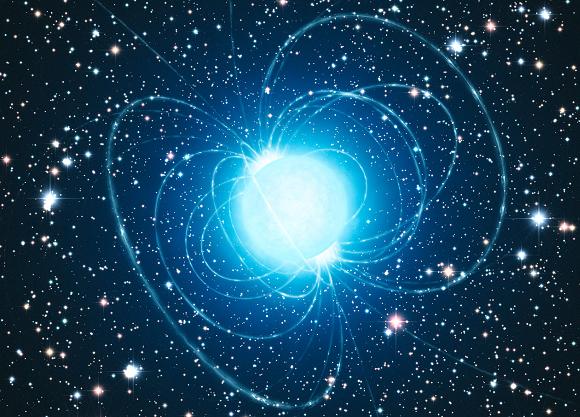This article is more than 1 year old
Boffins baffled by 'magnetar': Ought to be black hole, but isn't
Cluster conundrum amid the night of a thousand moons
Applecarts are pinwheeling through the air in the world's astronomy departments today as top boffins have revealed that stars lying within a certain range of ginormity do not, as had been supposed, turn into black holes. Rather, it seems, they instead become an exceptionally rare and puzzling space thing known to the astrocognoscenti as a "magnetar".

Post-supernova hyperimplosion damp squib.
A magnetar (pictured in concept form) is, of course, a type of neutron star (which, perhaps unexpectedly straightforwardly, is nothing more than a star made of neutrons) which has an outrageously powerful magnetic field a quadrillion times as strong as that of Earth.
International boffins found this starting fact out by probing a nearby (just 16,000 lightyears from here) stellar neighbourhood or cluster known as Westerlund 1.
Westerlund 1 is a sort of space version of America - everything is just a lot, lot bigger there. The place is stuffed with enormous stars too big to fit inside the orbit of Saturn, glaring out a million times the light of our own sun each.
"If the Sun were located at the heart of this remarkable cluster, our night sky would be full of hundreds of stars as bright as the full Moon," says Ben Ritchie, lead author of the supermegacluster magnetar black-hole-nixing team.
The assembled brainboxes, by means of cunning boffinry involving comparison of other stars in the cluster, determined that the star which turned into a magnetar must have been more than 40 times as massive as our own Sun, and thus - according to current thinking - ought to have turned into a black hole not a magnetar.
"This therefore raises the thorny question of just how massive a star has to be to collapse to form a black hole if stars over 40 times as heavy as our Sun cannot manage this feat," says Ritchie's fellow cluster-prober Norbert Langer.
Those with the brains to handle it can read the new paper here in pdf, courtesy of the European Southern Observatory (ESO) whose telescopes were used in the research. ®
Boffinnote
We here on the Reg boffinry desk are very sad to note the departure of eponymous ESO outreach operative Dr Henri Boffin for pastures new.
